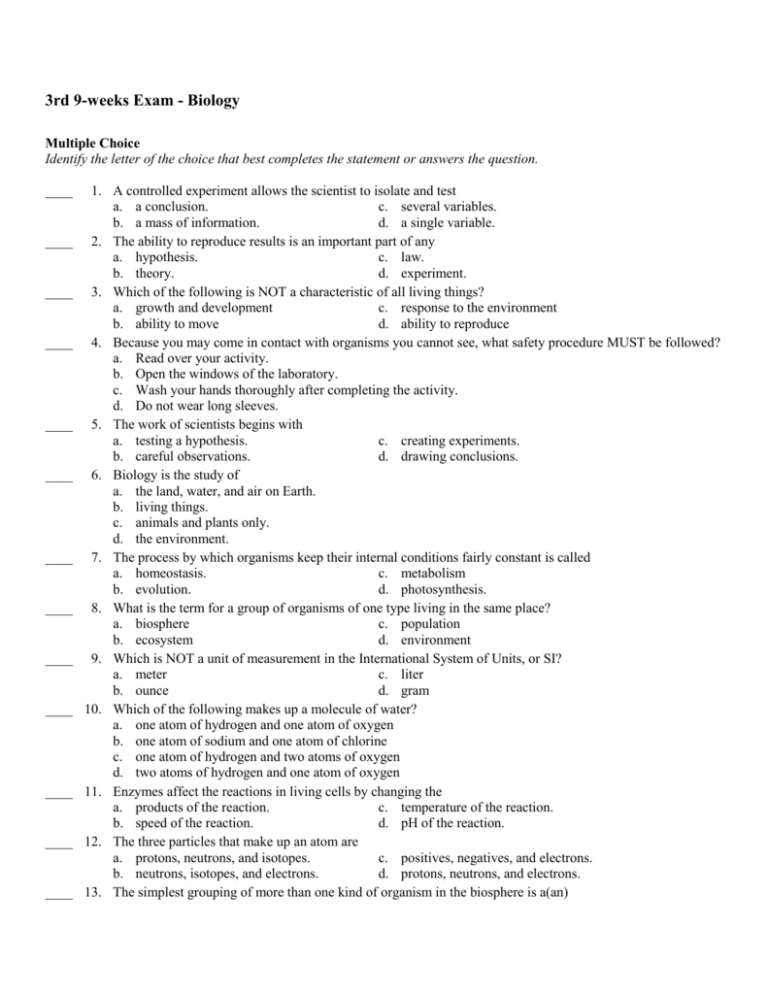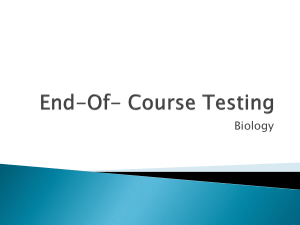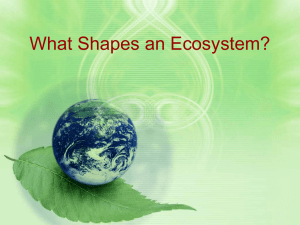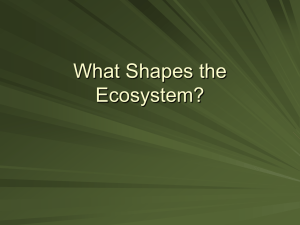3rd 9-weeks Exam
advertisement

3rd 9-weeks Exam - Biology Multiple Choice Identify the letter of the choice that best completes the statement or answers the question. ____ ____ ____ ____ ____ ____ ____ ____ ____ ____ ____ ____ ____ 1. A controlled experiment allows the scientist to isolate and test a. a conclusion. c. several variables. b. a mass of information. d. a single variable. 2. The ability to reproduce results is an important part of any a. hypothesis. c. law. b. theory. d. experiment. 3. Which of the following is NOT a characteristic of all living things? a. growth and development c. response to the environment b. ability to move d. ability to reproduce 4. Because you may come in contact with organisms you cannot see, what safety procedure MUST be followed? a. Read over your activity. b. Open the windows of the laboratory. c. Wash your hands thoroughly after completing the activity. d. Do not wear long sleeves. 5. The work of scientists begins with a. testing a hypothesis. c. creating experiments. b. careful observations. d. drawing conclusions. 6. Biology is the study of a. the land, water, and air on Earth. b. living things. c. animals and plants only. d. the environment. 7. The process by which organisms keep their internal conditions fairly constant is called a. homeostasis. c. metabolism b. evolution. d. photosynthesis. 8. What is the term for a group of organisms of one type living in the same place? a. biosphere c. population b. ecosystem d. environment 9. Which is NOT a unit of measurement in the International System of Units, or SI? a. meter c. liter b. ounce d. gram 10. Which of the following makes up a molecule of water? a. one atom of hydrogen and one atom of oxygen b. one atom of sodium and one atom of chlorine c. one atom of hydrogen and two atoms of oxygen d. two atoms of hydrogen and one atom of oxygen 11. Enzymes affect the reactions in living cells by changing the a. products of the reaction. c. temperature of the reaction. b. speed of the reaction. d. pH of the reaction. 12. The three particles that make up an atom are a. protons, neutrons, and isotopes. c. positives, negatives, and electrons. b. neutrons, isotopes, and electrons. d. protons, neutrons, and electrons. 13. The simplest grouping of more than one kind of organism in the biosphere is a(an) a. population. b. community. c. ecosystem. d. species. Figure 3-1 ____ 14. The algae at the beginning of the food chain in Figure 3-1 are a. consumers. c. producers. b. decomposers. d. heterotrophs. ____ 15. An organism that uses energy to produce its own food supply from inorganic compounds is called a(an) a. heterotroph. c. detritivore. b. consumer. d. autotroph. ____ 16. A snake that eats a frog that has eaten an insect that fed on a plant is a a. first-level producer. c. second-level producer. b. first-level consumer. d. third-level consumer. ____ 17. What is the combined portions of Earth called in which all living things exist? a. biome c. ecosystem b. community d. biosphere ____ 18. All of the members of a particular species that live in the same area are called a(an) a. biome. c. community. b. population. d. ecosystem. ____ 19. Green plants are a. producers. c. herbivores. b. consumers. d. omnivores. ____ 20. What is the original source of almost all the energy in most ecosystems? a. carbohydrates c. water b. sunlight d. carbon ____ 21. What is an organism that feeds only on plants called? a. carnivore c. omnivore b. herbivore d. detritivore ____ 22. Which type of pyramid shows the amount of living tissue at each trophic level in an ecosystem? a. a numbers pyramid c. a biomass pyramid b. an energy pyramid d. a food pyramid ____ 23. Climate is a global factor that produces a. Earth’s unique ocean and atmosphere. b. the shape and elevation of landmasses. c. a wide range of environmental conditions that shapes communities. d. solar energy within the atmosphere. ____ 24. Different species can share the same habitat, but competition among them is reduced if they a. reproduce at different times. c. increase their populations. b. eat less. d. occupy different niches. ____ 25. The symbiotic relationship between a flower and the insect that feeds on its nectar is an example of a. mutualism because the flower provides the insect with food, and the insect pollinates the flower. b. parasitism because the insect lives off the nectar from the flower. c. commensalism because the insect doesn’t harm the flower, and the flower doesn’t benefit from the relationship. d. predation because the insect feeds on the flower. ____ 26. What is one difference between primary and secondary succession? a. Primary succession is slow, and secondary succession is rapid. b. Secondary succession begins on soil, and primary succession begins on newly exposed surfaces. c. Primary succession modifies the environment, and secondary succession does not. d. Secondary succession begins with lichens, and primary succession begins with trees. ____ 27. Each of the following is an abiotic factor in the environment EXCEPT a. plant life. c. rainfall. b. soil type. d. temperature. ____ 28. An organism’s niche is a. the way the organism uses the range of physical and biological conditions in which it lives. b. all the physical factors in the organism’s environment. c. the range of temperatures that the organism needs to survive. d. a full description of the place an organism lives. ____ 29. An interaction in which one organism captures and feeds on another organism is called a. competition. c. mutualism. b. symbiosis. d. predation. ____ 30. Symbiosis in which both species benefit is called a. commensalism. c. predation. b. mutualism. d. parasitism. ____ 31. The series of predictable changes that occur in a community over time is called a. population growth. c. climax community. b. ecological succession. d. climate change. ____ 32. Primary succession can begin after a. a forest fire. c. farmland is abandoned. b. a lava flow. d. a severe storm. ____ 33. Which biome is characterized by very low temperatures, little precipitation, and permafrost? a. desert c. tundra b. temperate forest d. tropical dry forest ____ 34. The photic zone a. extends to the bottom of the open ocean. b. extends to a depth of about 200 meters. c. is deep, cold, and permanently dark. d. is where chemosynthetic bacteria are the producers. ____ 35. Which of the following is not likely to be a limiting factor on the sea otter population? a. disease c. drought b. competition d. predation ____ 36. Which will reduce competition within a species’ population? a. fewer individuals c. fewer resources b. higher birthrate d. higher population density ____ 37. The work of Schleiden and Schwann can be summarized by saying that ____ 38. ____ 39. ____ 40. ____ 41. ____ 42. ____ 43. ____ 44. ____ 45. ____ 46. ____ 47. ____ 48. ____ 49. ____ 50. a. all plants are made of cells. b. all animals are made of cells. c. plants and animals have specialized cells. d. all plants and animals are made of cells. Cells fall into two broad categories, depending on whether they a. have a cell wall. c. have a nucleus. b. contain genetic material. d. contain chloroplasts. Eukaryotes usually contain a. a nucleus. c. genetic material. b. specialized organelles. d. all of the above Which organelle makes proteins using coded instructions that come from the nucleus? a. Golgi apparatus c. vacuole b. mitochondrion d. ribosome Which organelle converts the chemical energy stored in food into compounds that are more convenient for the cell to use? a. chloroplast c. endoplasmic reticulum b. Golgi apparatus d. mitochondrion Which of the following is a function of the cell membrane? a. breaks down lipids, carbohydrates, and proteins from foods b. stores water, salt, proteins, and carbohydrates c. keeps the cell wall in place d. regulates which materials enter and leave the cell Diffusion occurs because a. molecules constantly move and collide with one another. b. the concentration of a solution is never the same throughout a solution. c. the concentration of a solution is always the same throughout a solution. d. molecules never move or collide with one another. An animal cell that is surrounded by fresh water will burst because the osmotic pressure causes a. water to move into the cell. c. solutes to move into the cell. b. water to move out of the cell. d. solutes to move out of the cell. Which organelle would you expect to find in plant cells? a. mitochondrion c. chloroplast b. ribosome d. smooth endoplasmic reticulum Which of the following structures serves as the cell’s boundary from its environment? a. mitochondrion c. chloroplast b. cell membrane d. channel proteins Diffusion is the movement of particles from a. an area of low concentration to an area of high concentration. b. an area of high concentration to an area of low concentration. c. an area of equilibrium to an area of high concentration. d. all of the above Which of the following is an example of an organ? a. heart c. digestive system b. epithelial tissue d. nerve cell A group of similar cells that perform a particular function is called a(an) a. organ. c. tissue. b. organ system. d. division of labor. Which of the following is an autotroph? ____ 51. ____ 52. ____ 53. ____ 54. ____ 55. ____ 56. ____ 57. ____ 58. ____ 59. ____ 60. ____ 61. ____ 62. ____ 63. ____ 64. a. mushroom c. monkey b. dog d. tree Energy is released from ATP when a. a phosphate group is added. c. ATP is exposed to sunlight. b. adenine bonds to ribose. d. a phosphate group is removed. Which of the following are used in the overall reactions for photosynthesis? a. carbon dioxide c. light b. water d. all of the above The light-collecting units of a chloroplast are the a. electron carriers. c. stroma. b. photosystems. d. high-energy sugars. What are the products of the light-dependent reactions? a. oxygen gas c. NADPH b. ATP d. all of the above If carbon dioxide is removed from a plant’s environment, what would you expect to happen to its production of high-energy sugars? a. More sugars will be produced. b. No sugars will be produced. c. The same number of sugars will be produced but without carbon dioxide. d. Carbon dioxide does not affect the production of high-energy sugars in plants. If you continue to increase the intensity of light that a plant receives, what happens? a. The rate of photosynthesis increases with light intensity. b. The rate of photosynthesis decreases with light intensity. c. The rate of photosynthesis increases and then levels off. d. The rate of photosynthesis does not change. Organisms, such as plants, that make their own food are called a. autotrophs. c. thylakoids. b. heterotrophs. d. pigments. Organisms that cannot make their own food and must obtain energy from the foods they eat are called a. autotrophs. c. thylakoids. b. heterotrophs. d. plants. Which of the following is NOT a part of an ATP molecule? a. adenine c. chlorophyll b. ribose d. phosphate Plants gather the sun’s energy with light-absorbing molecules called a. pigments. c. chloroplasts. b. thylakoids. d. glucose. Plants take in the sun’s energy by absorbing a. high-energy sugars. c. chlorophyll b. b. chlorophyll a. d. sunlight. Which of the following affects the rate of photosynthesis? a. water c. light intensity b. temperature d. all of the above Which of the following is NOT a stage of cellular respiration? a. fermentation c. glycolysis b. electron transport d. Krebs cycle One cause of muscle soreness is a. alcoholic fermentation. c. lactic acid fermentation. ____ 65. ____ 66. ____ 67. ____ 68. ____ 69. ____ 70. ____ 71. ____ 72. ____ 73. ____ 74. ____ 75. ____ 76. ____ 77. b. glycolysis. d. the Krebs cycle. Cellular respiration uses one molecule of glucose to produce a. 2 ATP molecules. c. 36 ATP molecules. b. 34 ATP molecules. d. 38 ATP molecules. Breathing heavily after running a race is your body’s way of a. making more citric acid. b. repaying an oxygen debt. c. restarting glycolysis. d. recharging the electron transport chain. Cellular respiration releases energy by breaking down a. food molecules. c. carbon dioxide. b. ATP. d. water. The two main types of fermentation are called a. alcoholic and aerobic. c. alcoholic and lactic acid. b. aerobic and anaerobic. d. lactic acid and anaerobic. Cellular respiration is called an aerobic process because it requires a. light. c. oxygen. b. exercise. d. glucose. As a cell becomes larger, its a. volume increases faster than its surface area. b. surface area increases faster than its volume. c. volume increases, but its surface area stays the same. d. surface area stays the same, but its volume increases. All of the following are problems that growth causes for cells EXCEPT a. DNA overload. c. obtaining enough food. b. excess oxygen. d. expelling wastes. Which of the following is NOT a way that cell division solves the problems of cell growth? a. Cell division provides each daughter cell with its own copy of DNA. b. Cell division increases the mass of the original cell. c. Cell division increases the surface area of the original cell. d. Cell division reduces the original cell’s volume. During which phase of mitosis do the chromosomes line up along the middle of the dividing cell? a. prophase c. metaphase b. telophase d. anaphase Which of the following represents the phases of mitosis in their proper sequence? a. prophase, metaphase, anaphase, telophase b. interphase, prophase, metaphase, anaphase, telophase c. interphase, prophase, metaphase, telophase d. prophase, metaphase, anaphase, telophase, cytokinesis What is the role of the spindle during mitosis? a. It helps separate the chromosomes. c. It duplicates the DNA. b. It breaks down the nuclear membrane. d. It divides the cell in half. Compared with small cells, large cells have more trouble a. dividing. b. producing daughter cells. c. moving needed materials in and waste products out. d. making copies of their DNA. The process by which a cell divides into two daughter cells is called ____ 78. ____ 79. ____ 80. ____ 81. ____ 82. ____ 83. ____ 84. ____ 85. a. cell division. c. interphase. b. metaphase. d. mitosis. Which of the following happens when a cell divides? a. The cell’s volume increases. b. It becomes more difficult for the cell to get enough oxygen and nutrients. c. The cell has DNA overload. d. Each daughter cell receives its own copy of the parent cell’s DNA. The cell cycle is the a. series of events that cells go through as they grow and divide. b. period of time between the birth and the death of a cell. c. time from prophase until cytokinesis. d. time it takes for one cell to undergo mitosis. Mendel concluded that traits are a. not inherited by offspring. b. inherited through the passing of factors from parents to offspring. c. determined by dominant factors only. d. determined by recessive factors only. When Mendel crossed true-breeding tall plants with true-breeding short plants, all the offspring were tall because a. the allele for tall plants is recessive. b. the allele for short plants is dominant. c. the allele for tall plants is dominant. d. they were true-breeding like their parents. The principles of probability can be used to a. predict the traits of the offspring produced by genetic crosses. b. determine the actual outcomes of genetic crosses. c. predict the traits of the parents used in genetic crosses. d. decide which organisms are best to use in genetic crosses. How many different allele combinations would be found in the gametes produced by a pea plant whose genotype was RrYY? a. 2 c. 8 b. 4 d. 16 If an organism’s diploid number is 12, its haploid number is a. 12. c. 24. b. 6. d. 3. What is shown in Figure 11-1? Figure 11–1 ____ 86. ____ 87. ____ 88. ____ 89. ____ 90. ____ 91. ____ 92. ____ 93. ____ 94. ____ 95. ____ 96. ____ 97. a. independent assortment c. crossing-over b. anaphase I of meiosis d. incomplete dominance Unlike mitosis, meiosis results in the formation of a. two genetically identical diploid cells. b. four genetically different haploid cells. c. four genetically identical haploid cells. d. two genetically different diploid cells. Gregor Mendel used pea plants to study a. flowering. c. the inheritance of traits. b. gamete formation. d. cross-pollination. What are Mendel’s factors called today? a. alleles c. genes b. traits d. characters The principle of dominance states that a. all alleles are dominant. b. all alleles are recessive. c. some alleles are dominant and others are recessive. d. alleles are neither dominant nor recessive. Two plants with the genotypes TT and Tt a. would have the same phenotype. c. have all dominant alleles. b. would have different phenotypes. d. have all recessive alleles. Organisms that have two identical alleles for a particular trait are said to be a. hybrid. c. heterozygous. b. homozygous. d. dominant. What principle states that during gamete formation genes for different traits separate without influencing each other’s inheritance? a. principle of dominance b. principle of independent assortment c. principle of probabilities d. principle of segregation Mendel’s principles of genetics apply to a. plants only. c. pea plants only. b. animals only. d. all organisms. The number of chromosomes in a gamete is represented by the symbol a. 2N. c. N. b. X. d. Y. Which of the following is a nucleotide found in DNA? a. ribose + phosphate group + thymine b. ribose + phosphate group + uracil c. deoxyribose + phosphate group + uracil d. deoxyribose + phosphate group + cytosine Unlike DNA, RNA contains a. adenine. c. phosphate groups. b. uracil. d. thymine. How many codons are needed to specify three amino acids? a. 3 c. 9 b. 6 d. 12 ____ 98. In eukaryotes, DNA a. is located in the nucleus. b. floats freely in the cytoplasm. ____ 99. RNA contains the sugar a. ribose. b. deoxyribose. ____ 100. Genes contain instructions for assembling a. purines. b. nucleosomes. c. is located in the ribosomes. d. is circular. c. glucose. d. lactose. c. proteins. d. pyrimidines.








